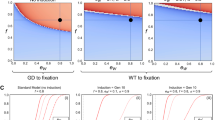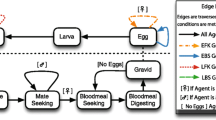Summary
A computer program, GENCON, designed to simulate genetic control using field-female killing systems, is described. These systems incorporate sex-linked translocations and conditional lethal mutations. Genetic death in field populations is caused by semisterility of the translocation and by homozygosis of the mutations in females and non-translocation males of field origin. Simulations using the program compare the effectiveness, in populations regulated by density, of genetic control using this type of system with control using sterile-male release. At high release rates, sterile males cause more rapid suppression and earlier eradication than sex-linked translocation strains. However, if releases are interrupted before eradication, the rate of recovery of density-dependent populations is more rapid following sterile-male release than following suppression with translocation strains. In such populations, the cumulative population suppression (number of individuals killed) is greater with translocation-strain release than with sterile-male release. At low release rates, sex-linked translocation strains can be much more effective at suppressing and eradicating density-dependent populations than sterile males. In continental Australia, eradication of the sheep blowfly Lucilia cuprina is probably not practicable. A suppression campaign using sex-linked translocation strains could yield a higher benefit to cost ratio than one using sterile males.
Similar content being viewed by others
References
Beck T, Moir B, Meppem T (1985) The cost of parasites to the Australian sheep industry. Q Rev Rur Econ 7:336–343
Bedo DG (1987) Specific recognition and differential affinity of meiotic X-Y pairing sites in Lucilia cuprina males (Diptera: Calliphoridae). Chromosoma 95:126–135
Dallwitz R (1984) The influence of constant and fluctuating temperatures on development rate and survival of pupae of the Australian sheep blowfly Lucilia cuprina. Entomol Exp Appl 36:89–95
Dallwitz R (1987) Density independence of survival in myiasis breeding of Lucilia cuprina (Diptera: Calliphoridae). Bull Entomol Res 77:171–176
Dietz K (1976) The effect of immigration on genetic control. Theor Popul Biol 9:58–67
Drake VA, Farrow RA (1985) A radar and aerial-trapping study of an early spring migration of moths (Lepidoptera) in inland New South Wales. Aust J Ecol 10:223–235
Foster GG (1982) The use of bridging systems to increase genetic variability in compound chromosome strains for genetic control of Lucilia cuprina (Wiedemann). Theor Appl Genet 63:295–305
Foster GG, Maddern RH (1985) Segregation and pairing of compound fifth-chromosomes in Lucilia cuprina males. Genet Res 46:149–168
Foster GG, Whitten MJ (1974) The development of genetic methods of controlling the Australian sheep blowfly, Lucilia cuprina. In: Pal R, Whitten MJ (eds) The use of genetics in insect control. Elsevier/North Holland, Amsterdam, pp 19–43
Foster GG, Kitching RL, Vogt WG, Whitten MJ (1975) Sheep blowfly and its control in the pastoral ecosystem in Australia. Proc Ecol Soc Aust 9:213–229
Foster GG, Maddern RH, Mills AT (1980) Genetic instbility in mass-rearing colonies of a sex-linked translocation strain of Lucilia cuprina (Wiedemann) (Diptera: Calliphoridae) during a field trial of genetic control. Theor Appl Genet 58:169–175
Foster GG, Whitten MJ, Konovalov C, Arnold JTA, Maffi G (1981) Autosomal genetic maps of the Australian sheep blowfly, Lucilia cuprina dorsalis R.-D. (Diptera: Calliphoridae), and possible correlations with the linkage groups of Musca domestica L. and Drosophila melanogaster (Mg.). Genet Res 37:55–69
Foster GG, Vogt WG, Woodburn TL (1985) Genetic analysis of field trials of sex-linked translocation strains for genetic control of the Australian sheep blowfly Lucilia cuprina (Wiedemann). Aust J Biol Sci 38:275–293
Graham NPH, Egerton JR (1968) Pathogenesis of ovine footrot: the role of some environmental factors. Aust Vet J 44:235–240
Helm KF (1975) Migration of the armyworm Persectania ewingii moths in spring and the origin of outbreaks. J Aust Entomol Soc 14:229–236
Hughes PB, McKenzie JA (1987) Insecticide resistance in the Australian sheep blowfly, Lucilia cuprina: speculation, science and strategies. In: Ford MG, Holloman DW, Khambay BPS, Sawicki RM (eds) Combating resistance to xenobiotics. Biological and chemical approaches. Ellis Horwood, Chichester, pp 162–177
Hughes RD, Nicholas WL (1974) The spring migration of the bushfly (Musca vetustissima Walk.): evidence of displacement provided by natural population markers including parasitism. J Anum Ecol 43:411–428
Krafsur ES, Whitten CJ, Novy JE (1987) Screwworm eradication in North and Central America. Parasitol Today 3:131–137
McKenzie JA (1976) The release of a compound-chromosome stock in a vineyard cellar population of Drosophila melanogaster. Genetics 82:685–695
McKenzie JA (1977) The effect of immigration on genetic control. A laboratory study with wild and compound chromosome stocks of Drosophila melanogaster. Theor Appl Genet 49:79–83
McKenzie JA, Whitten MJ (1982) Selection for insecticide resistance in the Australian sheep blowfly Lucilia cuprina. Experientia 38:84–85
Prout T (1978) The joint effects of the release of sterile males and immigration of fertilized females on a density regulated population. Theor Popul Biol 13:40–71
Robinson AS (1983) Sex-ratio manipulation in relation to insect pest control. Annu Rev Genet 17:191–214
Ryan AF (1954) The sheep blowfly problem in Tasmania. Aust Vet J 30:109–113
Ullerich FH (1963) Geschlechtschromosomen und Geschlechtsbestimmung bei einigen Calliphorinen (Calliphoridae, Diptera). Chromosoma 14:45–110
Vogt WG, Woodburn TL, Foster GG (1985) Ecological analysis of field trials conducted to assess the potential of sex-linked translocation strains for genetic control of the Australian sheep blowfly Lucilia cuprina (Wiedemann). Aust J Biol Sci 38:259–273
Wardhaugh KG, Read PA, Neave MJ (1988) A method of measuring the oviposition rate of the sheep blowfly Lucilia cuprina under field conditions. Aust Vet J 65:75–77
Watts JE, Murray MD, Graham NPH (1979) The blowfly strike problem of sheep in New South Wales, Aust Vet J 55:325–334
Whitten MJ (1969) Automated sexing of pupae and its usefulness in control by sterile insectrs. J Econ Entomol 62:272–273
Whitten MJ (1979) The use of genetically-selected strains for pest replacement or suppression. In: Hoy MA, McKelvey JJ Jr (eds) Genetics in Relation to Insect Management. The Rockefeller Foundation, New York, pp 31–40
Whitten MJ, Foster GG (1975) Genetical methods of pest control. Annu Rev Entomol 20:461–476
Whitten MJ, Foster GG, Vogt WG, Kitching RL, Woodburn TL, Konovalov C (1977) Current status of genetic control of the Australian sheep blowfly, Lucilia cuprina (Wiedemann) (Diptera: Calliphoridae). Proc XV Int Congr Entomol, 1976, Washington/DC, pp 129–139
Author information
Authors and Affiliations
Additional information
Communicated by J. S. F. Barker
Rights and permissions
About this article
Cite this article
Foster, G.G., Vogt, W.G., Woodburn, T.L. et al. Computer simulation of genetic control. Comparison of sterile males and field-female killing systems. Theoret. Appl. Genetics 76, 870–879 (1988). https://doi.org/10.1007/BF00273675
Received:
Accepted:
Issue Date:
DOI: https://doi.org/10.1007/BF00273675




